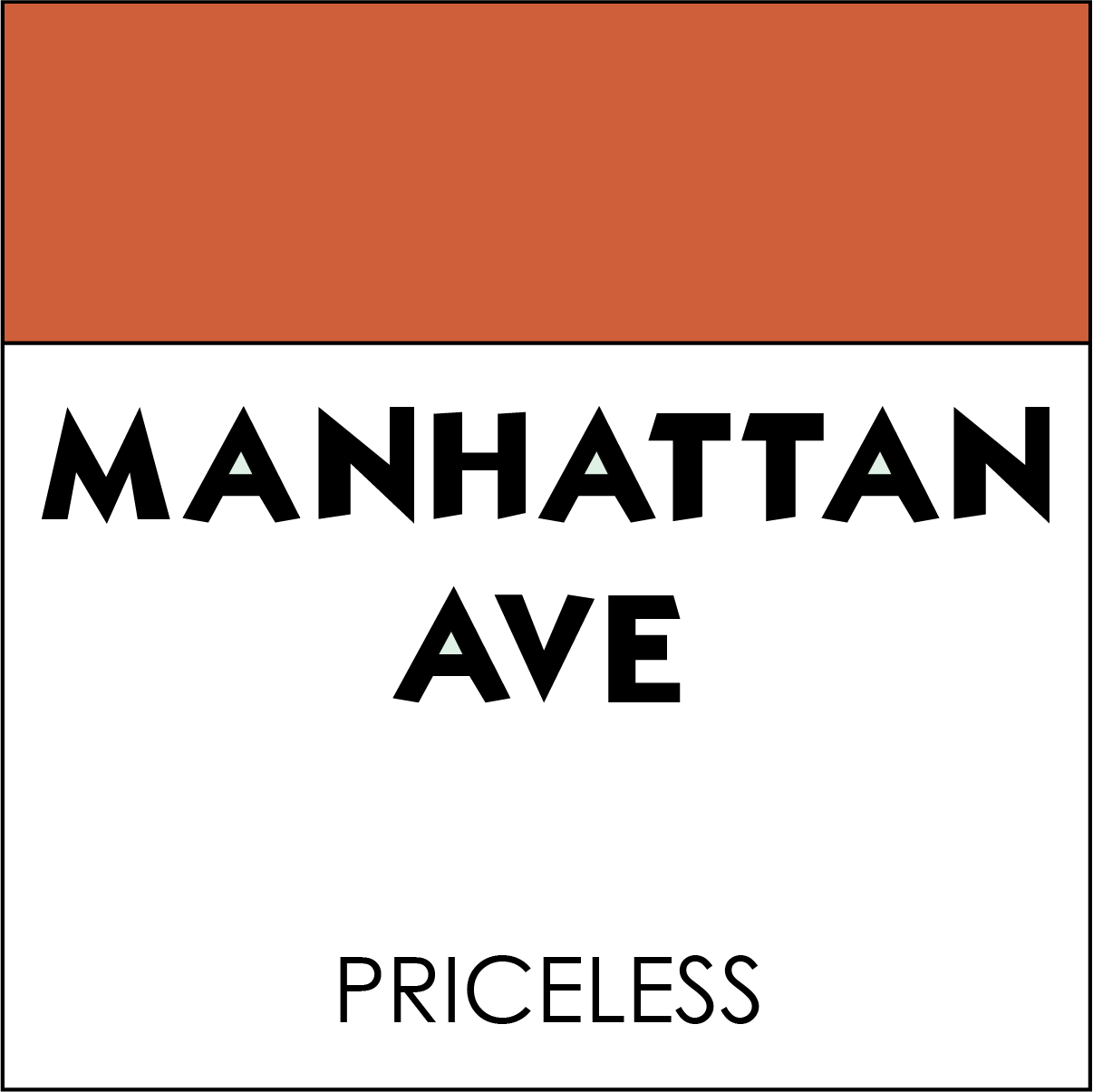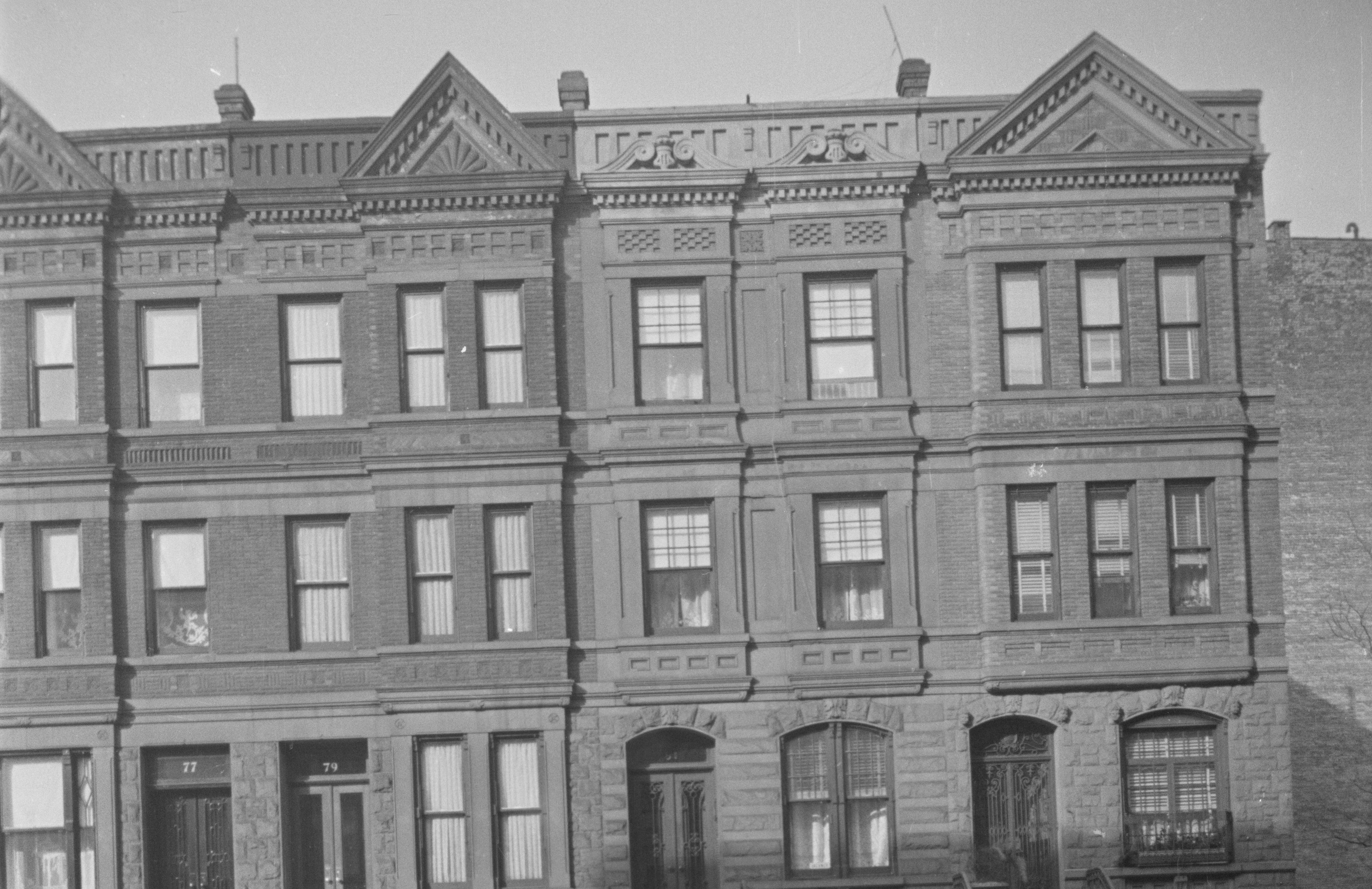
81 + 83 Manhattan Ave.
by Tom Miller
In 1890, William J. Davenport purchased a 100-foot-wide lot at the southwest corner of Manhattan Avenue and 104th Street. He commissioned architect William Howe to design a group of six, three-story-and-basement houses (73 through 83 Manhattan Avenue) on the site. The project was completed the following year. Howe had designed the Queen Anne-style row in an A-B-C-C-B-A configuration.
Nos. 81 and 83 Manhattan Avenue, like their mirror-image counterparts at the opposite end of the row, exhibited playful elements of the style. The identical basement and parlor levels of both were clad in undressed brownstone. The second and third stories of No. 81 were faced in planar stone and featured shallow, projecting bays that rose to denticulated cornices crowned with swan’s head pediments in front of a paneled parapet. The top two floors of No. 83 were clad in rough-faced Roman brick and held a single projecting bay. It supported a large, triangular gable that fronted a parapet that matched that of No. 81.
Davenport sold 81 Manhattan Avenue in 1893 to Elizabeth Strover for $17,000 (about $612,000 in 2025 terms). A widow, Elizabeth had a daughter, Marion (or Mary) Detjen, from a former marriage.
In May 1899, Frederick Akers moved into the house with the two women. The Evening World described him as “the horseman” and “a figure on the speedway and at the horse shows.” Prior to moving into 81 Manhattan Avenue, said The Evening World, he “lived at the Colonial Hotel, Harlem’s rendezvous of sporting men or sportsmen.” Akers was a coffee and spice merchant and owned a stock farm at Jerome Avenue and 177th Street.
Nos. 81 and 83 Manhattan Avenue, like their mirror-image counterparts at the opposite end of the row, exhibited playful elements of the style.
Two years after moving in, on April 26, 1901, Frederick Akers died in the house. His funeral was held in the parlor on April 30. Akers’ will, drawn in 1891, divided the bulk of his estate equally between his attorney and an old friend, Mrs. Morgan J. De Veau.
Elizabeth Strover died shortly afterward and Marion, now married and known as Marion Klinker, sold the house on April 20, 1905 to Walter A. and Genevieve G. Wells for $15,250.
Interestingly, later that year, in November, Marion Klinker sued Frederick Akers’ estate for $30,000. The Evening World reported on November 22, “she alleges Aker entered into with her two years before he died that he would leave her that sum in his will if she would nurse him the rest of his life.” Marion Klinker produced “many witnesses to this” in court, said the article. She was not aware, it seems, that the defense had “a dozen letters found in Akers’ safe after his death,” which the lawyers called “love letters” from Mary Detjen, “written before he went to live at her mother’s house.”
Two months later, on January 9, 1906, The Evening World reported that it was Marion Klinker who was the defendant in a suit. Akers’ executor, James P. Neimann, charged that Marion stole, “jewelry, bric-a-brac, paintings and rugs valued at $5,000” from his rooms. In court, Marion insisted that she knew nothing about the items, which included “opal bracelets, diamond rings, gold watches and chains and a pearl necklace consisting of one hundred pearls.” (The latter piece was valued at $3,500 alone.) When asked if she hadn’t told a deputy sheriff that she had sold the property, she huffed, “I never told him anything of the kind.” It is unclear how the two tangled suits worked out in the courts.
In the meantime, William J. Davenport leased 83 Manhattan Avenue to Henry Young, a graduate of Columbia University. Following Davenport’s death, his son Stephen, sold the house to the widowed Eva Wright, who was annually listed in Dau’s New York Social Blue Book. Sharing the house by 1909 was musician Julia Blaisdell, who had appeared on stage as early as 1861. On October 17, 1909, the New-York Tribune reported, “Julia Blaisdell, harpist and teacher, of No. 83 Manhattan avenue, has returned from Europe and resumed teaching and concert work.”
Walter and Genevieve Wells remained at 81 Manhattan Avenue until December 1920, when they sold it to Dr. Emil A. Pascal and his wife, Theresa M. Dr. Pascal operated his practice from the house. The Pascals, too, rented a room and in 1921 their tenant was 24-year-old Allen Clark.
At around 6:00 on the night of March 22 that year, residents of an apartment building on Keenan Place in Brooklyn “heard screams coming from the rooms of [Charles W.] James,” according to the New-York Tribune. Charles James was 45 years old and described by the newspaper as “a wealthy furrier, who is ill at his apartment.” The article continued, “A moment later, two men dashed from the house.”
A foot patrolman commandeered a passing automobile and overtook the two men, one of whom was Allen Clark. He took them back to the apartment. “James was found tied to his bed unconscious,” said the New-York Tribune. When he regained consciousness, James identified the pair “who had beaten him insensible with a cane.” The men had not taken anything from the apartment, and so their motive is unclear.
The article continued, “A moment later, two men dashed from the house.”
No. 83 Manhattan Avenue was sold in August 1919 to Lorenzo S. and Mildred Viola Everson. Born in 1869 and 1878 respectively, they were married in 1892 and had six children. A mechanical engineer, Everson was the chief engineer with the real estate firm Weil & Mayer.
It appears that 81 Manhattan Avenue was being operated as rented rooms when mid-century approached. Living here in the summer of 1949 was 29-year-old Dorothy Grant. She went to Staten Island, presumably on a date, on June 17 that year. Her escort turned out not to be the gentlemanly type. The Staten Island Advance reported that police were “seeking a man who is said to have punched Dorothy Grant…during an argument last night.” Dorothy was treated for a face cut.
Dorothy was among the last of the residents of 81 and 83 Manhattan Avenue. In 1952, plans were laid for a massive urban renewal project called the Frederick Douglass Houses. Within a few years, the entire block had been eliminated.
Tom Miller is a social historian and blogger at daytoninmanhattan.blogspot.com


